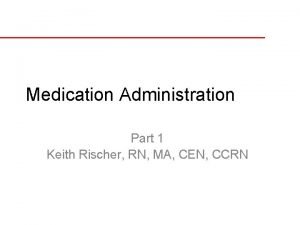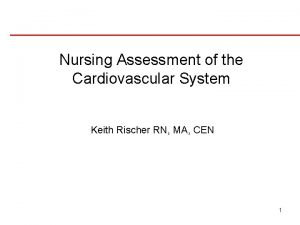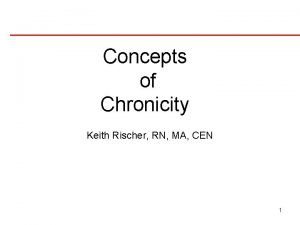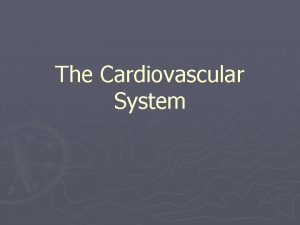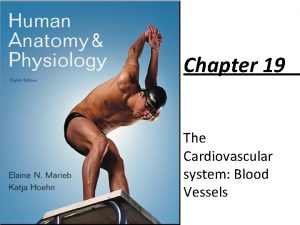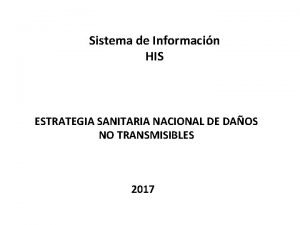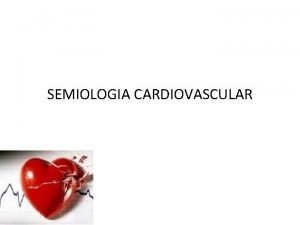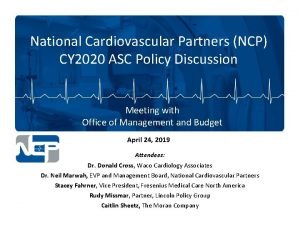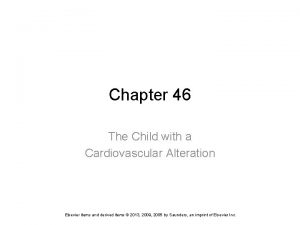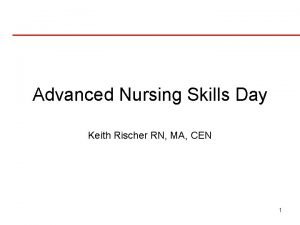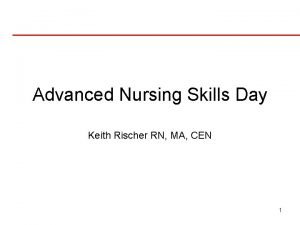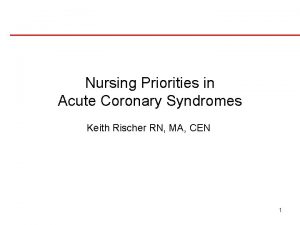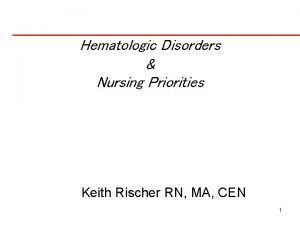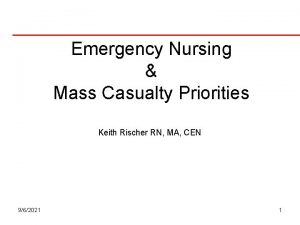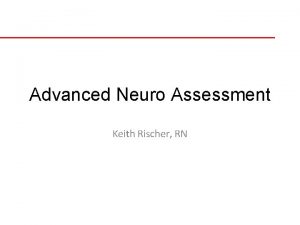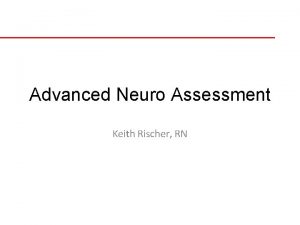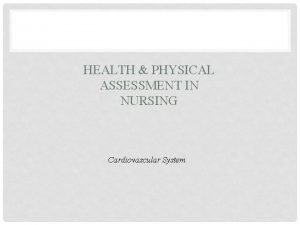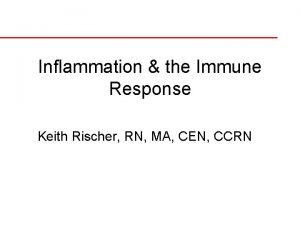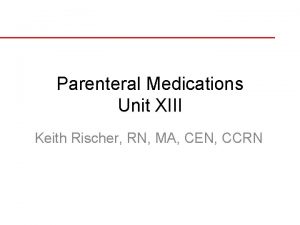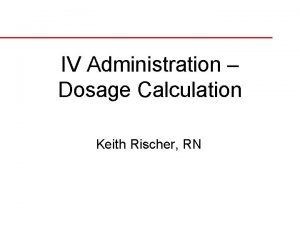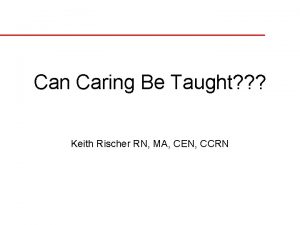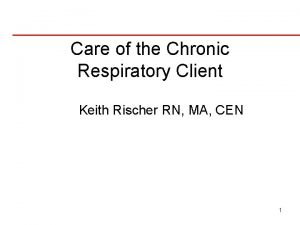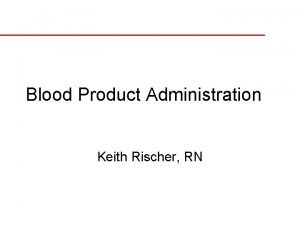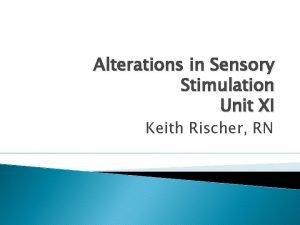Nursing Assessment of the Cardiovascular System Keith Rischer































- Slides: 31

Nursing Assessment of the Cardiovascular System Keith Rischer RN, MA, CEN 1

Today’s Objectives… Ø Ø Ø Review the anatomy and physiology of the cardiovascular system. Describe cardiovascular changes associated with aging. Identify factors that place patients at risk for cardiovascular problems. Explain and describe pre- and post-care associated with diagnostic cardiovascular testing. Explain the purpose of hemodynamic monitoring. 2

Aortic-Pulmonic Mitral-Tricuspid 3

Coronary Arteries Ø Ø Ø Right Coronary Left Anterior Descending Circumflex 4

Cardiac Conduction SA node Both Atria AV Node Both Ventricles Bundle of His Bundle Branches - Perkinje Fibers 5

Diastole Ø Ø Ø Lower # in BP (120/80) Ventricles are relaxed Passively fill from atria 6

Systole Ø Ø Ø Higher # in BP (120/80) Ventricles are contracting and emptying SBP accurately reflects afterload 7

Cardiac Output v. CO = Stroke volume x heart rate v. SV (80 cc) x HR (80)= 6400 cc (6. 4 lpm) • Daily pumps 1800 gallons • 657, 000 gallons every year • Over 80 year lifetime: • 52, 560, 000 gallons 8

Preload: Right side of heart Ø Ø Ø Preload=primarily venous blood return to RA Right and left side of heart filling pressure (atria>ventricles) Pressure/Stretch in ventricles end diastole 9

Starling’s Law of the Heart Ø Ø Ø Maximum efficency of CO achieved when myocardium stretched appx 2 ½ times length Think rubber band CO decreased with lower preload/filling pressures or too high 10

“AFTER” load: Left side of heart Ø Force of resistance that the LV must generate to open aortic valve Ø Correlates w/SBP 11

Contractility Ø Ability of heart to change force of contraction without changing resting length Ø Influenced by Ca++ Ø Inotropic-Influencing contractility independent of Starling mechanism q Positive inotropic q Negative inotropic 12

Assessment Techniques Ø History q Demographic data ü Age ü Gender ü Pre vs. post menopause q Family history and genetic risk q Personal medical history ü DM, HTN ü BCP use for women q Diet 13

Modifiable Risk Factors Cigarette smoking Ø Physical inactivity Ø Obesity Ø Psychological factors Ø Chronic disease Ø 14

Changes with Aging Ø Ø Ø Calcification in valves Pacemaker cells decrease in number Conduction time increases Left ventricle increases Aorta and large vessels thicken and become stiffer Baroreceptors less sensitive 15

Women & CAD Ø Ø Vague-atypical chief c/o q Only 53% have CP as chief c/o q Fatigue chief c/o Typically develop CAD 10+ years later then men Mortality twice as high q Less likely to have definitive 12 lead EKG q Smaller coronary arteries q Higher prevalence of silent ischemia q CABG higher mortality rate/complications q After first MI-more likely to suffer fatal event Women > 50 pay must address HTN, high cholesterol, family history, diabetes 16

Men Ø Ø Develop 10 -15 years earlier Initial event AMI Classic CP sx Develop greater collateral circulation compared to women Women Ø Ø Influence of menopause… 4 x risk Causes more deaths in women than men Initial event angina Atypical CP sx…fatigue 17

Elderly & CAD Ø More likely to have vague, atypical c/o Ø SOB, fatigue, syncope or falls Ø Any fall must be investigated for mitigating circumstances Ø Less likely to have radiation 18

Clinical Manifestations: Dyspnea Ø Ø Ø Can occur as a result of both cardiac and pulmonary disease Difficult or labored breathing experienced as uncomfortable breathing or shortness of breath Dyspnea on exertion (DOE) Orthopnea q dyspnea when lying flat Paroxysmal nocturnal dyspnea (PND) q after lying down for several hours 19

Other Clinical Manifestations Ø Ø Ø Fatigue Palpitations Weight gain Syncope Extremity pain Ischemia q Venous insufficiency q 20

CV Physical Assessment Ø Ø Ø General appearance Integumentary system Skin color Skin temperature Extremities Blood pressure q Ø Orthostatic Arterial pulses q Jugular venous distention 21

Precordium q Auscultation ü Normal heart sounds…S 1 S 2 ü Paradoxical splitting ü Gallops – S 3 – S 4 ü Murmurs – Systolic most common ü Pericardial friction rub 22

Serum Markers of Myocardial Damage Ø Ø Ø Troponin B-Natruetic Peptide Serum lipids C-reactive protein Lytes K+ q Mg++ q Ø Blood coagulation q PT & INR 23

Brain Natriuetic Peptide: BNP Ø Ø Ø 95 % of BNP resides in ventricles As pressure inc in ventricles in HF-BNP is released Bodies own ACE/B-blocker Only lab test that measures HF Normal is less than 100 q Elevated 100 -500 q + for CHF >500 Ø Uses: dx- assess response to tx 24

Cardiac Catheterization Ø Ø Ø Client preparation Possible complications: myocardial infarction, stroke, thromboembolism, arterial bleeding, lethal dysrhythmias, and death Pre-procedure: q Review procedure (video) q Consent q NPO or light breakfast q Cath site shaved q Premeds - sedative 25

Cardiac Catheterization Ø Procedure q q Ø Pt awake – report any chest pain or symptoms May proceed to Stent Placement Follow-up care: q q q Restricted bedrest, insertion site extremity kept straight Assess groin site and distal pulses closely Monitor vital signs Force fluids Assess for complications 26

Cardiac Catheterization Report 27

Other Diagnostic Tests 12 lead EKG Ø Holter monitor (ambulatory) Ø Electrophysiologic (EP) study Ø Exercise Stress test Ø Echocardiography Ø q Pharmacologic stress echocardiogram q Transesophageal echocardiogram Ø Thallium imaging 28

Hemodynamic Monitoring: Arterial Line 29

Hemodynamic Monitoring: Pulmonary Artery catheter 30

Hemodynamic Monitoring Strips 31
 Keith rischer
Keith rischer 12 lead ekg
12 lead ekg Keith rischer
Keith rischer Keith rischer
Keith rischer Wolters kluwer
Wolters kluwer The circulatory or cardiovascular system chapter 19
The circulatory or cardiovascular system chapter 19 What makes up the cardiovascular system
What makes up the cardiovascular system Pithed rat
Pithed rat Cardiovascular/lymphatic system it's totally tubular
Cardiovascular/lymphatic system it's totally tubular Crash course circulatory system
Crash course circulatory system Chapter 5 the cardiovascular system labeling exercises
Chapter 5 the cardiovascular system labeling exercises Figure 11-7 veins labeled
Figure 11-7 veins labeled Figure 11-14 is a diagram of a capillary bed
Figure 11-14 is a diagram of a capillary bed Chapter 11 the cardiovascular system
Chapter 11 the cardiovascular system Lesson 11 cardiovascular system
Lesson 11 cardiovascular system Circulatory system tissue
Circulatory system tissue Hypertensive atherosclerotic cardiovascular disease
Hypertensive atherosclerotic cardiovascular disease Introduction of heart
Introduction of heart Stent placement
Stent placement Anatomy and physiology unit 7 cardiovascular system
Anatomy and physiology unit 7 cardiovascular system Chapter 8 cardiovascular system
Chapter 8 cardiovascular system Chapter 13 cardiovascular system
Chapter 13 cardiovascular system Chapter 11 the cardiovascular system figure 11-2
Chapter 11 the cardiovascular system figure 11-2 The cardiovascular system includes the
The cardiovascular system includes the Chapter 19 cardiovascular system blood
Chapter 19 cardiovascular system blood Venule
Venule Riesgo cardiovascular por perimetro abdominal
Riesgo cardiovascular por perimetro abdominal Maniobra de azoulay
Maniobra de azoulay Rias de hipertension arterial
Rias de hipertension arterial Fresenius ncp
Fresenius ncp When does stroke volume increase
When does stroke volume increase Chapter 46 the child with a cardiovascular alteration
Chapter 46 the child with a cardiovascular alteration
